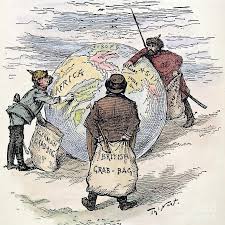“New Imperialism: Motivations and Methods” – Everything You Need to Know
In the late 19th and early 20th centuries, European powers, along with emerging states, embarked on a phase of expansion that dramatically reshaped global political and economic landscapes. This period—known as New Imperialism—was characterized by a new wave of colonization, driven by a mix of economic ambitions, national pride, and cultural ideologies. In this comprehensive guide on New Imperialism: Motivations and Methods, we will explore the forces behind this era of expansion, examine the strategies and tactics employed by imperial powers, and discuss its lasting impact on the modern world. Whether you’re a history enthusiast, a student of political science, or simply curious about how empires were built and maintained, this article will equip you with a nuanced understanding of one of history’s most influential phenomena.
Introduction: Unpacking an Era of Expansion and Ambition
Imagine a world where entire continents were divided up by distant powers, where local cultures were dramatically reshaped by foreign rule, and where the quest for economic and political dominance spurred intense competition on a global scale. Did you know that at its peak, New Imperialism saw European countries controlling vast territories in Africa, Asia, and the Pacific, profoundly influencing international trade, culture, and politics? In this post on New Imperialism: Motivations and Methods, we will cover:
- A clear definition of New Imperialism, outlining its key characteristics and distinguishing features.
- The historical context and critical milestones that set the stage for this phase of global expansion.
- A detailed exploration of the motivations behind imperialist ambitions and the methods used to implement and maintain control.
- Real-world examples and case studies that illustrate how imperial powers exerted their influence.
- The importance of understanding these processes for modern discussions on globalization, post-colonialism, and international relations.
- Common misconceptions and frequently asked questions to clear up misunderstandings.
- Modern relevance and current trends, highlighting how the legacy of New Imperialism continues to affect global dynamics today.
By understanding New Imperialism: Motivations and Methods, you’ll gain valuable insights into the driving forces behind empire-building and the complex interplay of economic, political, and cultural factors that still shape our world.
What Is “New Imperialism: Motivations and Methods”?
Defining the Concept
New Imperialism: Motivations and Methods refers to the phase of imperial expansion that occurred primarily during the late 19th and early 20th centuries. This era was marked by the systematic acquisition of overseas territories by European powers, the United States, and Japan. Unlike earlier forms of imperialism—which were often based on conquest and settlement—New Imperialism was characterized by:
Economic Exploitation:
Seeking new markets for manufactured goods, sources of raw materials, and investment opportunities to fuel industrial growth.Political and Strategic Interests:
Establishing military bases, securing trade routes, and gaining geopolitical leverage over rival powers.Cultural and Ideological Justifications:
Promoting a sense of national superiority, spreading Christianity and Western values, and employing the rhetoric of the “civilizing mission” to justify expansion.Advanced Methods of Administration:
Utilizing modern technologies (such as steamships, telegraphs, and railroads) and administrative innovations to control and integrate distant territories.
In essence, New Imperialism: Motivations and Methods encapsulates the multifaceted drivers and techniques behind one of history’s most significant periods of global expansion—a period that not only reshaped continents but also left an enduring legacy in international relations and cultural exchanges.
Historical and Contextual Background
The Road to New Imperialism
Before the advent of New Imperialism, global expansion had been driven largely by mercantilism and early colonial ventures. However, several developments in the 19th century set the stage for a more aggressive, systematic, and far-reaching phase of imperialism.
Economic and Industrial Transformations
The Industrial Revolution:
Beginning in the late 18th century, the Industrial Revolution radically transformed economies by shifting production from artisanal methods to mechanized factories. This led to increased production capacities, higher demand for raw materials, and a need for new markets—factors that fueled imperial ambitions.Capital Accumulation and Financial Innovations:
The rapid growth of industrial capitalism created vast fortunes and sophisticated banking systems. European powers, flush with capital, sought to invest surplus funds in overseas ventures, further motivating territorial acquisitions.Technological Advancements:
Innovations such as the steam engine, telegraph, and modern navigation techniques made long-distance travel and communication more efficient, facilitating the expansion and administration of far-flung colonies.
Political and Strategic Drivers
National Rivalries:
The competitive nature of European politics intensified during the 19th century. As nations vied for global dominance, acquiring new territories became a matter of national pride and strategic necessity. The scramble for Africa is one prominent example of how rivalries fueled imperial expansion.Military and Naval Power:
Advancements in military technology, including ironclad warships and improved artillery, enabled imperial powers to project force over great distances. The development of modern navies allowed for the rapid deployment of troops and the establishment of fortified bases around the world.
Ideological and Cultural Influences
The Civilizing Mission:
Many imperial powers justified their expansion by claiming they were bringing civilization, Christianity, and progress to “backward” societies. This paternalistic ideology, often encapsulated in the phrase “the white man’s burden,” provided a moral rationale for imperial domination.Social Darwinism:
Although a misapplication of biological principles, Social Darwinist ideas gained traction in the late 19th century, promoting the belief that competition among nations was natural and that only the strongest should thrive. This ideology reinforced notions of racial superiority and justified the subjugation of colonized peoples.
Notable Historical Milestones and Anecdotes
The Scramble for Africa:
In the late 19th century, European powers divided Africa among themselves with little regard for indigenous cultures or political boundaries. The Berlin Conference of 1884–1885 epitomizes this era, where European nations negotiated territorial claims without African representation.Expansion in Asia:
The United States and Japan also entered the imperialist arena during this period. The annexation of Hawaii, the colonization of the Philippines, and Japan’s victory in the Russo-Japanese War (1904–1905) are key examples of how imperial ambitions extended beyond Europe.Technological Triumphs:
The construction of railways, telegraph lines, and steamship routes not only facilitated imperial expansion but also symbolized the technological prowess of the era, reinforcing the belief in progress and modernity.
In-Depth Exploration / Main Body
To fully understand New Imperialism: Motivations and Methods, we must explore its various dimensions. The following sections break down the key components and illustrate how these factors interacted to shape one of history’s most transformative periods.
1. Economic Motivations and Methods
a. Capitalism and the Quest for Markets
Demand for Raw Materials:
The rapid industrialization of Europe created a voracious appetite for raw materials such as rubber, oil, cotton, and minerals. Colonies provided these essential resources at relatively low costs.New Markets for Manufactured Goods:
As production increased, European industries faced the challenge of surplus goods. Colonies served as captive markets for these products, ensuring a steady stream of revenue.Financial Investments:
The accumulation of capital and the development of sophisticated financial markets enabled imperial powers to invest heavily in colonial ventures. Banks and investment firms played critical roles in financing infrastructure projects, such as railways and ports, that were essential for economic integration.
b. Technological Advancements in Commerce
Transportation Innovations:
The advent of steamships and railroads revolutionized global trade. These technologies drastically reduced the time and cost of transporting goods, facilitating the flow of raw materials from colonies to factories and finished products back to markets.Communication Breakthroughs:
The telegraph and later the telephone enabled instantaneous communication across vast distances. This connectivity allowed imperial administrations to coordinate complex commercial operations and manage global supply chains efficiently.
c. Real-World Example: The British Empire
Economic Exploitation:
The British Empire is a quintessential example of New Imperialism, with its vast colonial network providing both raw materials and new markets. The economic policies implemented in colonies like India and parts of Africa were designed to benefit Britain’s industrial and financial sectors.Infrastructure Development:
Investments in railroads, telegraph lines, and port facilities in colonies not only facilitated commerce but also symbolized the technological and administrative capabilities of the imperial power.
2. Political Motivations and Diplomatic Methods
a. National Rivalries and the Quest for Global Dominance
The Balance of Power:
In an era of intense national competition, the acquisition of colonies was seen as a marker of national strength. European powers, and later the United States and Japan, were driven by the need to assert themselves on the global stage.Geopolitical Strategies:
Imperial expansion was often intertwined with military strategy. Establishing naval bases and securing strategic territories provided a military advantage, ensuring that a nation could protect its interests and project power internationally.Diplomatic Negotiations:
Conferences such as the Berlin Conference of 1884–1885 illustrate how imperial powers negotiated territorial claims among themselves, attempting to manage rivalries and prevent conflict through diplomatic means.
b. Ideological Justifications: The Civilizing Mission and Social Darwinism
The Civilizing Mission:
Many imperial powers justified their expansion by claiming that they were bringing civilization, education, and Christianity to supposedly “primitive” peoples. This ideology was used to legitimize colonial rule and mitigate criticism of economic exploitation.Social Darwinism in Politics:
The misapplication of Darwinian principles to human societies led to the belief that competition and natural selection should govern international relations. This ideology provided a pseudo-scientific rationale for the dominance of stronger nations over weaker ones.Cultural Propaganda:
Imperial powers often used art, literature, and education to promote a positive image of imperialism. This propaganda reinforced the belief that colonial rule was a benevolent force for progress and development.
c. Real-World Example: The Scramble for Africa
Diplomatic Tensions:
The division of Africa among European powers led to significant diplomatic tensions. The Berlin Conference, which arbitrarily partitioned the continent, is a stark example of how diplomatic negotiations were used to manage rivalries while disregarding local populations.Legacy of Conflict:
The colonial borders drawn during this period have had lasting impacts, contributing to ongoing ethnic conflicts and political instability in many African nations.
3. Social and Cultural Motivations and Methods
a. The Role of National Identity and Cultural Pride
Cultural Revival:
The age of New Imperialism was not solely about economic or political gain; it was also driven by a deep sense of cultural pride and identity. Many imperial powers believed that their culture was superior and that they had a duty to spread their values to other parts of the world.Language, Art, and Education:
Efforts to promote the imperial language, literature, and educational systems were central to the cultural aspect of imperialism. These initiatives helped integrate colonies into the imperial fold, albeit often at the expense of indigenous cultures.Case Study – French Colonialism:
In its African and Asian colonies, France implemented policies of “assimilation,” aiming to transform colonial subjects into French citizens by imposing French language, culture, and legal systems.
b. Social Darwinism and Racial Theories
Pseudo-Scientific Justifications:
Social Darwinism, along with related racial theories, provided a framework to justify the superiority of certain races and the inferiority of others. These ideas were used to legitimize the exploitation and subjugation of colonized peoples.Impact on Policy:
Racial hierarchies influenced everything from labor policies and legal rights to educational opportunities in colonial territories.Ethical Repercussions:
The legacy of Social Darwinism has been deeply controversial, contributing to systemic racism and ongoing debates over reparations and historical justice.
4. Economic, Political, and Cultural Intersections
a. Integrating Economic and Political Strategies
Holistic Statecraft:
Successful imperial ventures often integrated economic, political, and cultural strategies to consolidate control over vast territories. By aligning trade policies with diplomatic objectives and cultural assimilation programs, imperial powers created cohesive systems of governance.Case Study – The British Raj in India:
The British in India implemented a range of policies that blended economic exploitation with administrative reforms and cultural propagation. Railways, telegraphs, and a codified legal system transformed India’s infrastructure, while English education and cultural institutions aimed to reshape Indian society along Western lines.
b. Long-Term Impacts on Global Relations
Shaping Modern Borders:
The territorial divisions imposed during New Imperialism have had a lasting impact on global geopolitics. Many modern conflicts can trace their origins to the arbitrary borders drawn by imperial powers.Cultural Legacies:
The cultural policies of imperial powers continue to influence the languages, educational systems, and social norms of former colonies, contributing to a complex legacy of both progress and cultural loss.Economic Dependencies:
Many former colonies continue to grapple with economic structures that were designed to benefit imperial powers, highlighting the enduring impact of economic imperialism.
Importance, Applications, and Benefits
Understanding New Imperialism: Motivations and Methods is vital for multiple reasons, impacting diverse fields from history and politics to economics and cultural studies.
a. Informing Modern International Relations
Policy Lessons:
The diplomatic strategies and rivalries of the New Imperialism era provide critical lessons for managing modern international relations. Understanding historical conflicts over territory and influence can help contemporary policymakers avoid similar pitfalls.Conflict Resolution:
By analyzing the causes and consequences of imperial rivalries, diplomats can develop more effective strategies for conflict resolution and peacekeeping in today’s interconnected world.
b. Enhancing Historical and Cultural Literacy
Cultural Awareness:
A deeper understanding of imperial motivations enriches our knowledge of world history and the diverse cultures affected by imperial rule. This awareness can foster empathy and support for efforts to address historical injustices.Educational Enrichment:
Integrating the study of New Imperialism into educational curricula encourages critical thinking about the ethical, social, and political dimensions of global history.
c. Economic and Political Insights
Economic Policy Development:
Insights from New Imperialism inform modern economic policies, especially in addressing the legacies of colonial exploitation and fostering sustainable development in formerly colonized regions.Political Reform:
Understanding the interplay of nationalism, imperial ambition, and diplomatic strategy can guide current debates on state sovereignty, globalization, and national identity.
d. Global and Future Implications
Transnational Collaboration:
The history of imperialism offers valuable lessons for modern transnational cooperation. As global challenges like climate change and economic inequality require collective action, understanding past power dynamics is essential for fostering effective international partnerships.Anticipating Future Trends:
By studying the methods and motivations of New Imperialism, scholars and policymakers can better anticipate the evolution of global power structures and adapt to shifting geopolitical realities.
Addressing Common Misconceptions and FAQs
Despite extensive scholarship on New Imperialism, several misconceptions persist. Here are some frequently asked questions and clarifications:
FAQ 1: Is New Imperialism solely about economic exploitation?
- Misconception:
Many assume that the primary goal of New Imperialism was purely economic, aimed at extracting resources. - Reality:
While economic motives were significant, New Imperialism was also driven by political, strategic, and cultural factors. It was about securing national prestige, establishing military footholds, and spreading cultural and ideological values.
FAQ 2: Did New Imperialism only affect Africa and Asia?
- Misconception:
Some believe that New Imperialism was limited to certain regions. - Reality:
Although Africa and Asia were major targets, New Imperialism also shaped events in the Pacific, the Caribbean, and parts of Latin America. Its global reach has left a lasting impact on international borders and cultural dynamics.
FAQ 3: Were the methods of New Imperialism always violent?
- Misconception:
It is often assumed that imperial expansion was solely achieved through warfare and coercion. - Reality:
While military force played a role in many cases, diplomacy, economic pressure, and cultural assimilation were also key components of imperial strategy. The approach varied depending on the context and objectives of the imperial power.
FAQ 4: Is the legacy of New Imperialism irrelevant in today’s global politics?
- Misconception:
Critics sometimes argue that since New Imperialism ended decades ago, it has little relevance today. - Reality:
The legacies of territorial boundaries, economic dependencies, and cultural influences established during this era continue to affect global politics, international relations, and social structures around the world.
Modern Relevance and Current Trends
a. Globalization and Its Complex Legacy
Economic Globalization:
The global trade networks and financial systems established during the era of New Imperialism laid the groundwork for modern globalization. While these systems have contributed to economic growth, they also perpetuate disparities that echo colonial patterns.Political and Cultural Legacies:
National borders and cultural identities forged during New Imperialism still influence international relations and domestic policies in many countries today.
b. Debates on Neocolonialism and Post-Colonialism
Modern Critiques:
Scholars and activists continue to debate the extent to which modern economic and political systems reflect the legacy of imperialism. Terms like “neocolonialism” highlight the ongoing influence of former imperial powers in shaping global economics and politics.Efforts for Redress:
International organizations and governments are increasingly focused on addressing historical injustices through policies aimed at economic redistribution, cultural preservation, and political empowerment in formerly colonized regions.
c. The Role of Technology in Modern Imperialism
Digital Colonialism:
Some contemporary critics argue that technology companies and digital platforms are establishing new forms of imperial control by dominating global markets and influencing cultural trends. This modern form of “imperialism” raises questions about the power dynamics of information and technology.Data and Surveillance:
The use of advanced surveillance and data analytics by states and corporations reflects a new frontier of control and influence, echoing historical practices of resource extraction and cultural domination.
d. Educational and Cultural Initiatives
Revisiting History:
There is a growing movement to critically reassess the legacies of New Imperialism in academic curricula, museums, and public discourse. This educational push aims to foster a more nuanced understanding of how historical imperial practices continue to shape our world.Cultural Revival and Reconciliation:
Efforts to revive indigenous languages, traditions, and cultural practices are part of a broader initiative to redress the cultural erasure that accompanied imperial expansion.
Conclusion: The Lasting Impact of New Imperialism
Summarizing the Key Points
New Imperialism: Motivations and Methods is a multifaceted historical phenomenon that transformed the world through a combination of economic ambition, strategic maneuvering, and cultural ideologies. Key takeaways include:
Economic and Political Drivers:
New Imperialism was driven by the need for raw materials, new markets, and geopolitical power, as well as by national rivalries and the desire for cultural superiority.Diverse Methods:
Imperial powers employed a range of methods—from military conquest and diplomatic negotiation to economic pressure and cultural assimilation—to expand their influence.Enduring Legacies:
The impacts of New Imperialism are still evident today in global trade networks, international borders, cultural dynamics, and ongoing debates over neocolonialism and post-colonial identity.Complex Motivations:
Understanding the motivations behind imperial expansion—economic, political, and ideological—provides critical insights into the forces that continue to shape our globalized world.
Reinforcing the Importance of Understanding New Imperialism
Grasping New Imperialism: Motivations and Methods is essential for comprehending how historical processes of expansion and domination continue to influence contemporary international relations, economic policies, and cultural identities. By studying this era, we not only learn from the past but also gain valuable perspectives that inform current debates and guide future policy decisions.
A Call-to-Action
We invite you to:
- Explore Further:
Delve into historical texts, documentaries, and academic research on New Imperialism to enrich your understanding of how imperial strategies evolved and their impact on the modern world. - Engage in Discussion:
Share your insights, questions, and experiences in the comments below or on our social media platforms. How do you see the legacy of New Imperialism affecting global politics and cultural identity today? - Stay Informed:
Subscribe to our newsletter for more in-depth articles on historical transformations, international relations, and cultural studies. Your participation helps create a community of informed citizens dedicated to understanding and addressing the complexities of our global heritage.
Additional Resources and Further Reading
For those interested in expanding their knowledge on New Imperialism: Motivations and Methods, consider these reputable sources:
Books and Academic Journals:
- Imperialism: A Study by J.A. Hobson
- The Scramble for Africa by Thomas Pakenham
- Empire: How Britain Made the Modern World by Niall Ferguson
- Scholarly articles in journals such as The Journal of Imperial and Commonwealth History and Diplomatic History.
Digital Archives and Museums:
- The Digital Public Library of America (DPLA) for primary sources on imperial expansion.
- Europeana Collections, featuring digitized documents and artifacts related to New Imperialism.
Government and Educational Websites:
- Resources from the British Library and the U.S. Library of Congress.
- Online courses on platforms like Coursera and edX covering imperial history and international relations.
Interactive Timelines and Documentaries:
- Multimedia timelines on History.com that detail the major events of New Imperialism.
- Documentaries available on PBS, Netflix, or YouTube exploring the impact of imperial expansion on different regions of the world.
Final Thoughts
The era of New Imperialism: Motivations and Methods represents a pivotal chapter in global history—one that reshaped nations, redefined power dynamics, and left an indelible mark on cultural and economic landscapes. By examining the motivations behind imperial expansion and the diverse methods used to implement it, we gain a clearer understanding of how historical forces continue to influence contemporary international relations, economic policies, and cultural identities.
Thank you for joining us on this comprehensive exploration of New Imperialism: Motivations and Methods. If you found this post insightful, please share it with friends, colleagues, and anyone interested in understanding the enduring impact of imperial strategies on our modern world. Let’s continue the conversation and work together to build a future informed by the lessons of our past.







